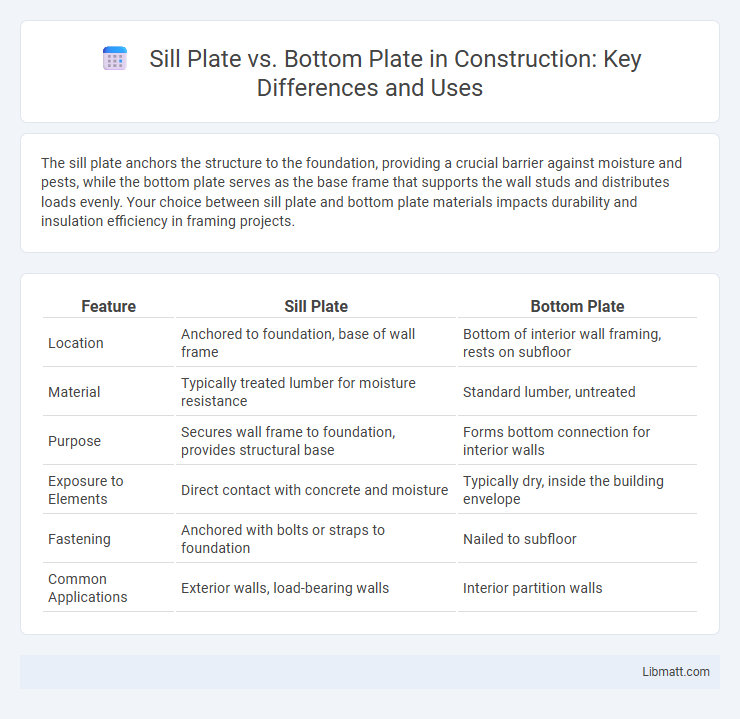The sill plate anchors the structure to the foundation, providing a crucial barrier against moisture and pests, while the bottom plate serves as the base frame that supports the wall studs and distributes loads evenly. Your choice between sill plate and bottom plate materials impacts durability and insulation efficiency in framing projects.
Table of Comparison
| Feature | Sill Plate | Bottom Plate |
|---|---|---|
| Location | Anchored to foundation, base of wall frame | Bottom of interior wall framing, rests on subfloor |
| Material | Typically treated lumber for moisture resistance | Standard lumber, untreated |
| Purpose | Secures wall frame to foundation, provides structural base | Forms bottom connection for interior walls |
| Exposure to Elements | Direct contact with concrete and moisture | Typically dry, inside the building envelope |
| Fastening | Anchored with bolts or straps to foundation | Nailed to subfloor |
| Common Applications | Exterior walls, load-bearing walls | Interior partition walls |
Introduction to Sill Plates and Bottom Plates
Sill plates serve as the foundational horizontal timber anchored directly to the concrete slab or foundation, providing a secure base for wall framing. Bottom plates, also known as sole plates, rest on the subfloor and form the lower boundary of wall studs, ensuring proper alignment and structural stability. Both components are essential in distributing loads and maintaining the wall's vertical integrity in residential and commercial construction.
Definitions: What is a Sill Plate?
A sill plate is a horizontal, treated wooden board anchored to a building's foundation that serves as the base for wall framing. It provides structural support by connecting the framing to the foundation and helps distribute loads evenly. Unlike the bottom plate, which is located at the bottom of the wall framing and rests on the floor structure, the sill plate directly interfaces with the foundation to ensure stability and moisture resistance.
Definitions: What is a Bottom Plate?
A bottom plate, also known as a sole plate, is a horizontal framing member located at the base of a wall structure, typically resting on the foundation or floor slab. It serves as the anchor point for vertical studs and distributes structural loads evenly across the foundation. Understanding the role of the bottom plate helps you ensure proper stability and alignment in your building's framing system.
Key Differences Between Sill Plate and Bottom Plate
The sill plate is the bottom horizontal member attached directly to the foundation, serving as a base for wall framing and anchoring the structure to the foundation with anchor bolts. The bottom plate, also called the sole plate, sits on top of the subfloor or slab and forms the base for wall studs, providing a nailing surface and alignment for framing. Key differences include their location--sill plates connect to the foundation, while bottom plates are part of the framed wall--and their material treatment, as sill plates often use pressure-treated wood to resist moisture and decay, unlike typical bottom plates.
Functions and Roles in Framing
Sill plates serve as the critical interface between the foundation and the framing, anchoring the structure and providing a level base for wall construction. Bottom plates, also known as sole plates, are located at the base of interior and exterior walls, securing wall studs in place and distributing weight evenly. Understanding the distinct roles of your sill and bottom plates ensures proper load transfer and structural integrity in framing projects.
Materials Used for Sill Plates vs Bottom Plates
Sill plates are typically made from pressure-treated lumber to resist moisture and decay since they rest directly on the foundation, while bottom plates often use standard untreated lumber because they sit above the subfloor and are less exposed to damp conditions. Both sill plates and bottom plates are commonly constructed from softwoods like pine, fir, or spruce, but the critical distinction lies in the treatment and durability requirements driven by their respective placements. Understanding these material differences helps ensure your framing's longevity and structural integrity.
Installation Methods: Sill Plate vs Bottom Plate
Sill plates are installed directly on the foundation wall using anchor bolts embedded in concrete to ensure a secure connection and prevent lateral movement. Bottom plates, also known as sole plates, are fastened to the subfloor or slab and serve as the base for wall studs, typically attached with nails or screws. Proper installation of both plates is crucial for structural integrity and moisture resistance in wood-framed buildings.
Building Codes and Requirements
Building codes require sill plates to be pressure-treated lumber or naturally resistant to decay to prevent moisture damage and ensure structural stability. Bottom plates, also called sole plates, are typically standard lumber but must meet local code specifications regarding size and fastening to the floor system. Your compliance with these regulations ensures a durable foundation and safe load transfer from walls to the building's foundation.
Common Mistakes and How to Avoid Them
Common mistakes when installing sill plates include improper anchoring to the foundation, which can compromise structural stability and lead to shifting or settling over time. Bottom plates often suffer from incorrect alignment or using untreated lumber in moisture-prone areas, causing rot and weakening the frame. To avoid these issues, ensure sill plates are securely anchored with appropriate anchor bolts or straps, and use pressure-treated wood for bottom plates to enhance durability and prevent water damage.
Choosing the Right Plate for Your Project
Selecting the right plate for your construction project depends on the framing type and location within the structure. Sill plates are anchored directly to the foundation and provide a stable base for wall framing, making them essential for exterior walls in contact with concrete. Bottom plates, used in interior wall framing, sit atop the subfloor and support vertical studs, allowing for easier adjustments and repairs.
Sill plate vs Bottom plate Infographic

 libmatt.com
libmatt.com